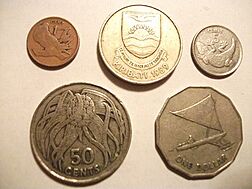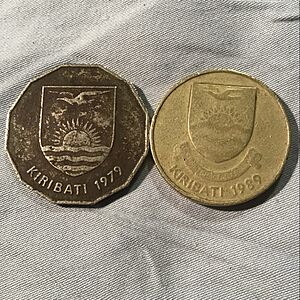Kiribati dollar facts for kids
Quick facts for kids Kiribati dollar |
|||
|---|---|---|---|
|
|||
| ISO 4217 Code | none | ||
| User(s) | |||
| Inflation | 0.5% | ||
| Source | The World Factbook, 2005 est. | ||
| Pegged with | Australian dollar at par | ||
| Subunit | |||
| 1⁄100 | cent | ||
| Symbol | $ | ||
| cent | ¢ | ||
| Coins | 5¢, 10¢, 20¢, 50¢, $1, $2 | ||
| Banknotes | Australian notes circulate | ||
The Kiribati dollar is one of the two official money types used in Kiribati, a country made of islands in the Pacific Ocean. Kiribati coins are linked directly to the Australian dollar. This means one Kiribati dollar is always worth the same as one Australian dollar.
Kiribati started making its own coins in 1979. These coins are used alongside Australian banknotes (paper money) and coins. Today, Kiribati coins are quite rare. The last small amount of new coins was made in 1992. Because they are hard to find, these older coins are now mostly collected by people who like to gather coins. The main times Kiribati made coins were in 1979 and again in 1989. The 1989 coins celebrated ten years since Kiribati became an independent country.
Contents
History of Kiribati's Money
Before Kiribati became an independent country, it was part of the Gilbert and Ellice Islands. From 1966 to 1979, people there used Australian coins. Before Australia started using dollars, the Australian pound was the main money. This was especially true after World War I. The Gilbert and Ellice Islands also printed their own banknotes in the 1940s. These could be exchanged for British pounds.
During World War II, some of the islands were taken over by Japan. During this time, a special money called the Oceanian pound was used. This was paper money created by the Japanese Government for the Pacific region. After the war ended, the Australian pound became the official money again. It had always been used in the islands that Japan did not occupy.
When Kiribati became independent in 1979, leaders wanted to show its new status. They decided to make their own coins. Even though Australian banknotes would still be used, most people liked the idea of having their own coins. In 1989, a two-dollar coin was made. It replaced the two-dollar paper note and marked the country's tenth birthday.
Kiribati Coins: What They Look Like
Kiribati's first coins came out in 1979, right after the country became independent. They were directly linked to the Australian dollar. The first coins were in values of 1, 2, 5, 10, 20, and 50 cents, and 1 dollar.
Most of these coins are the same size, weight, and material as Australian coins. The 1 and 2 cent coins were made of bronze. The 5, 10, 20, 50 cent coins, and the 1 dollar coin were made of cupro-nickel. This is a mix of copper and nickel. The smaller coins (1 to 20 cents) are similar to other Pacific island countries' coins. However, the larger coins are special to Kiribati.
The Kiribati 50-cent coin is round with ridged edges. This is different from the Australian 50-cent coin, which has twelve sides. The Kiribati 1 dollar coin also has twelve sides, like Australia's 50-cent coin. But the Kiribati 1 dollar coin is smaller and lighter.
In 1989, new 2 dollar coins were made from nickel-brass. This happened when Kiribati celebrated its tenth year of independence. It also followed Australia's decision to make a 2 dollar coin and stop using the 2 dollar paper note in 1988. The Kiribati 2 dollar coin is round and much bigger than Australia's 2 dollar coin. It is about the same size around as the 20-cent coin.
Most Kiribati coins have the year 1979 on them. This marks the year of independence. But there are some exceptions. In 1992, Kiribati made more 1 and 2 cent coins. These were made of copper-plated steel. They also made 5 cent coins from nickel-plated steel. These newer coins look shinier and stick to a magnet. They were made because Australia stopped making its 1 and 2 cent coins. However, a small number of 1992 one-cent coins were still made from bronze. There haven't been new 10, 20, 50 cent, or 1 dollar coins since then. So, most of these coins only have the 1979 date. Even though Kiribati kept making 1 and 2 cent coins longer than Australia, they are not used much anymore. This is because they are worth very little.
Kiribati does not make its own coins anymore. So, most Kiribati coins you find are either brand new from a bank or very old and worn out. Australian coins are now more common in busy areas. The government finds it easier and cheaper to use Australian coins instead of making more Kiribati coins.
On one side of all Kiribati coins, you can see the national crest. This is the country's official symbol. The other side shows plants, animals, and important cultural items from the islands. A sculptor and engraver named Michael Hibbit designed these coins.
Here's what you can see on the back of the coins:
| Value | Diameter | Composition | 1979–1989 | |
|---|---|---|---|---|
| Front Side | Back Side | |||
| 1 cent | 17.5 mm | Bronze | Coat of arms | Frigatebirds (a type of bird) |
| 2 cents | 21.6 mm | Coat of arms | Babai plant (a local plant) | |
| 5 cents | 19.3 mm | Cupronickel | Coat of arms | Gecko (a small lizard) |
| 10 cents | 23.6 mm | Coat of arms | Breadfruit (a type of fruit) | |
| 20 cents | 28.45 mm | Coat of arms | Dolphins | |
| 50 cents | 31.65 mm | Coat of arms | Pandanus tree (a common tree) | |
| 1 dollar | 30 mm | Coat of arms | Outrigger canoe (a traditional boat) | |
| 2 dollars | 29 mm | Nickel-Brass | Coat of arms | Maneaba (a traditional meeting house)/"Tenth Anniversary of Independence" |
Banknotes: Paper Money in Kiribati
Before 1966, Australian pound Sterling banknotes were used in the Gilbert Islands. These were introduced in 1914. In 1942, during wartime, the Gilbert and Ellice Islands Government printed their own local banknotes. These notes had a simple design and were worth the same as British pounds. They came in values like 1, 2, 5, and 10 shillings, and 1 pound. After the war, these notes were stopped and slowly taken out of use. Because they are so rare now, these notes are very valuable to collectors.
In 1966, the new Australian dollar became the official money for the Gilbert and Ellice Islands. It replaced the pound notes. At first, only 1, 2, and 10 dollar notes were used. Later, 5, 20, 50, and 100 dollar notes were also sent for use. The Australian dollar continued to be the official money even after the Gilbert and Ellice colonies separated. It remained the money after Kiribati became independent. The 1 dollar notes were used alongside a local Kiribati coin.
Later, the 1 and 2 dollar paper notes were taken out of use. Kiribati and Australia both started using coins for these values instead.
See also



